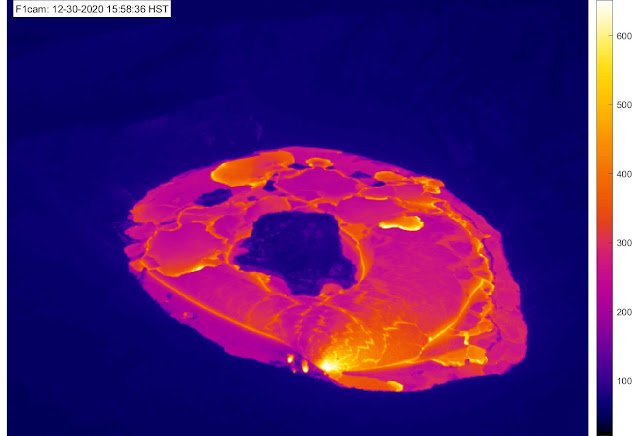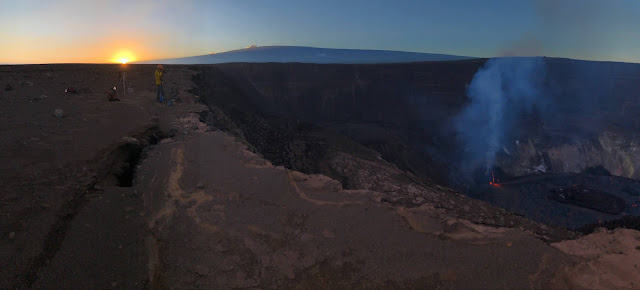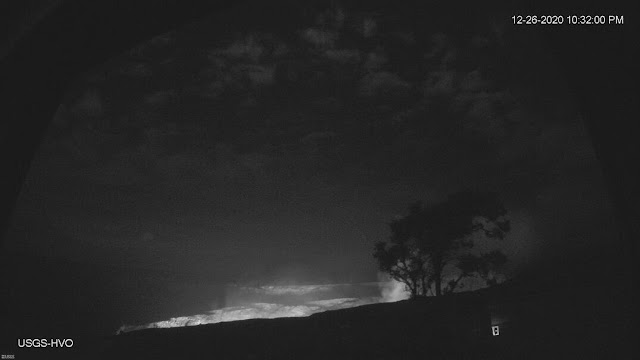How we wish for stability...but...might get bored. That balancing act of growth, change, or stagnation. The eternal rollercoaster. On this chillcold (63dF at 930a) light rainy morning here on the heights... breezy tradebreezes push fogs, mists, and drizzles to Kaluapele. Bring jacket and hot beverages. Then a kīpuka of bluesky and teasing sunshine...change.
Kaluapele
31 December 2020
Thursday, December 31, 2020. Status quo-ing Stabilities...
30 December 2020
Wednesday, December 30, 2020. And yet another sunny morning...
And She continues her work...I am always grateful for sunshine. It elevates my mood and seems to make the birds happy too. A bit breezy up here, but all is good. The moon is fat, and moonlit nights are a favorite. I remember playing cards by moonlight on the white sand at Maniniʻōwali decades ago. Because we could. And hoaloha crossing lava flows, pāhoehoe and ʻaʻā in moonlight, guided by white koʻa (coral) cobbles placed along the path as (moon)light posts. And then, a night that lives in memories amongst a small group of us: At Pāpaʻi, in Māhealani light, giving a palaka jacket to the surf: "Nani wale a ka mahina..."
And on another of our fair isles, on a shore of Maui, from friend kr:
Ahhhh Sweet, Evocative Memories!!! And at Kaluapele last night, by the light of mahina and Pele...the KWcam seems to have been adjusted to allow better, clearer, viewing...And too, the moonlit sky allows a bit of perspective.
Of Tilt, that is...Long term trends are often most important. Is magma filling or is lava flowing? And of course situations change very very quickly...
29 December 2020
Tuesday, December 29, 2020. That morning glow...
As I type, the just-risen sun fills the living room with yelloworange glow. Already, just more than a week after winter solstice, shadow on the wall marks the towardsummer movement of the sun, just a few inches past the PostIt marker. We mark time, though Pelehonuamea works on her own unfathomable schedule. "What you see is what you get" couldnʻt be more appropriate. No matter our selfish desires, we arenʻt in control, though we may think we are...
Shall we vote for Most Scenic Workplace??? Pretty sure the above would win. Yesterday as the sun set behind Maunaloa and Pele played low-key, HVO staff were on the scene. Please note the near-absence of clouds; a rare time at the summit of Kīlauea.
Just prior to sunset yesterday, this was a webcam view in the other direction. Annotations hopefully clarify location. Kūpinaʻi Pali is a traditional name for Waldron Ledge, a popular viewpoint near the Visitor Center. "Kūpinaʻi", "echo" is what happens, especially if youʻre on the floor and call out to vertical pali. From the top, hikers can be clearly heard chatting a few hundred feet below.
And please note that "moku lana au" is a descriptor, rather than a Name. Moku = island, lana = adrift, au = to flow, as a current.
These precious days of winter clear often come with light, variable, and even slack winds...rather than scud, clouds seem to stand still as they morph and shapeshift.
Iʻll sign off, as helicopters, a big annoyance, thrum overhead...gotta head to town today. The Update hasnʻt been posted yet, so Iʻll let you GoLook...
Be well, take good care of each other, and WEAR A MASK...
As always, with aloha,
BobbyC
maniniowali@gmail.com
28 December 2020
Monday, December 28, 2020. Of places we adore...
Yet another dazzling winter day. Chill air, sunshine, all is good...
Apropos my comment Saturday about alohaing our ʻāina, it occurred to me to mention that songs celebrating place are an integral part of our culture. If so inclined, one could sing ones way around each of our fair isles, recognizing the bestest aspects of place. Sadly, many songs are being forgotten. Theyʻre too old-fashioned; not current or in vogue. Iʻm old-fashioned, and I adore them. Many make for the best hula ʻauana...
Kaluapele sits proudly in the Moku (District) of Kaʻū, a vast area on the south part of the Island of Hawaiʻi. And the song "Kaʻū Nui" is dear. A few (several?) years ago I had the pleasure of being part of a UH Hilo huakaʻi (field trip) visiting places around the summit of Kīlauea. We ended on the lānai at Jaggar Museum where the group sang...
I LOVE this!!! "The wondrous beauty of Kīlauea" indeed...
And then, getting geographically specifically apropos, and slowing down somewhat, we enjoy Napua and her version of "Halemaʻumaʻu". Ahhhhh
Apologies for differently sized text...I trust that they suffice.
So here we are...Grateful for the monitoring and documentation of HVO staff...
Sunrise today on the rim, shot by a geologist with the Hawaiian Volcano Observatory, posted today on the HVO website...The area is CLOSED because of HAZARDS. Including no moʻ road, uahi ʻawa, etc.
Pay Attention when you Go Outside!!!
The National Park Service posts signs and erects barricades to inform visitors and to educate them. Unfortunately, too many visitors are seemingly illiterate, or think warnings donʻt apply to them. "Ainokea. I do what I like." Thatʻs the mentality. Then rescuers are put at risk... Cʻmon people. BEHAVE...
But of course Iʻll guess that miscreants donʻt read or pay attention to this. Gotta try but...
So The Tilt:
Going up but not too fast...This is for the last week, the blue depicts ground motion at Uēkahuna.And a final, current views of Halemaʻumaʻu, from webcams more or less in the same position in the CLOSED AREA on the rim...
And a map image from a similar vantage, for those concerned that She might overflow hither and yon, wreaking havoc and destruction...
Till next time (probably Wednesday), as always, with aloha,
BobbyC
maniniowali@gmail.com
27 December 2020
Sunday, December 27, 2020. She continues under clear sky
Weʻve been fortunate that the weathers have been kind to us. Mostly. This morning, sky is clear, temperature is a bit nippy, with gentle breezes here at Keaʻau ma uka. Last night though...I was wakened by flashes of lightning and rumbles of thunder at maybe 230a. In dreamfog becoming conscious, I heard paka ua...big fat raindrops paka paka paka on the iron roof. And of course I immediately thought that the summit was exploding and gravel was raining down. Of course. That didnʻt happen, and I am grateful, but we think of these things. The thunderstorm moved away, and I returned to slumber.
Found yesterday a new webcam. Up on the Maunaloa Strip Road. A bit pixillated are the images, but they work.
Seems a great way to watch sunrise online. This morning we see tradewinds wafting the wispy plume toward Kaʻū (to the right from Kaluapele). With the North Vent taking a rest, a hoʻomaha, much less fume is being emitted. Many call the plume "smoke" or "steam". Smoke comes from burning...wood or whatla, steam, from vaporization of liquid. Fume consists of various gases released from magma as it surfaces and pressure is released. Gases escape and rise up. Yes, mostly water vapor, but also sulphur dioxide and carbon dioxide and others. The link below is excellent, from the University of Hawaiʻi Weather site. But most times, just Go Outside Pay Attention...youʻll know whether or not itʻs voggy.
And from our friends at USGS Hawaiian Volcano Observatory:
Monitoring Volcanic Gas in Hawaiʻi
And we remote watch and see what Pelehonuamea is working on at the moment:
Tilt seems to be flattening...perhaps an equilibrium of sorts, when incoming equals outgoing. Maybe.As always, with aloha,
BobbyC
maniniowali@gmail.com
26 December 2020
Saturday, December 26, 2020. Hmmmm. Whatʻs She up to?
Always something new... On this heavy-skyed overcast morning, early webcam images were darkish and kinda gloomy looking. So we went here there and here again as camera images were refreshed.
Itʻs a bit geographically challenging. Maps are generally oriented with North at the top, South at the bottom, and East West right left. But because of the cameras positions on a rim of Kaluapele, the North Vent is at the left, and the West Vent at the bottom. Takes awhile to get that fixed in my brain.
I looked first at the KW cam:
It turned to inflation (upward) at 2a or so. Hmmm
And so Pelehonuamea continues her work.
Below at 851a, we see red at the bottom...
And then The Update at 914a:
But in the end, for many of us, Aloha ʻĀina for our ʻĀina Aloha shall endure. Always pau ʻole.
me ke aloha till next time,
BobbyC
maniniowali@gmail.com

























































